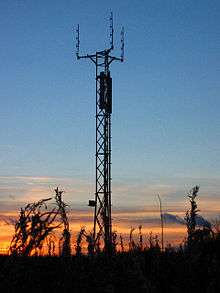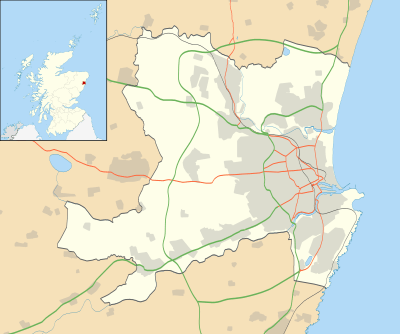Peterculter
Peterculter /ˌpiːtərˈkuːtər/ (![]()

Peterculter
| |
|---|---|
 Peterculter Location within the City of Aberdeen | |
| Population | 7,220 (2012)[1] |
| OS grid reference | NJ840007 |
| Council area |
|
| Lieutenancy area | |
| Country | Scotland |
| Sovereign state | United Kingdom |
| Post town | PETERCULTER |
| Postcode district | AB14 |
| Dialling code | 01224 |
| Police | Scotland |
| Fire | Scottish |
| Ambulance | Scottish |
| UK Parliament | |
| Scottish Parliament | |
| Website | http://www.culter.net/ |
The latter part of the name is said to come from the Gaelic compound word "Cul-tir", which signifies the "back part" of the country.
History
About one mile south west of the Peterculter is the site of the Roman marching camp at Normandykes.
King William the Lion bestowed the church of Kulter, "iuxta Abirdene", upon the Abbey and monks of St Mary of Kelso, about 1165–1199. The gift was afterwards confirmed by Mathew, Bishop of Aberdeen, within whose diocese the church sat.
Alan of Soltre, chaplain, who had probably been an ecclesiastic of the hospital, or monastery of Soutra, in Lothian, was presented by the Abbot of Kelso, to the vicarage of the church of Culter, 1239–1240.
In 1287–1288, an agreement was made between the Abbot and Convent of Kelso and the brotherhood of the Knights of Jerusalem, regarding the Templars’ lands of Blairs and Kincolsi (Kincousie, now Kincaussie[4]), on the south side of the Dee, by which a chapel, built by the Templars at their house of Culter, was recognised as a church, with parochial rights, for the inhabitants of the said lands. It was this agreement that changed the existing parish of Culter into two separate parishes with two separate names, the other being Maryculter.
Attractions
.jpg)
High up on the steep, rocky bank of the Culter Burn near the western exit of the village was a colourful and well-tended kilted wooden figure holding a broadsword and targe (shield) that represents Rob Roy Macgregor, who according to local legend leapt across the stream at that point to flee pursuing Hanoverian troops (Given the width of the stream there, the story - which has its local variants in many parts of Scotland - is unlikely to have much basis in fact). The outlaw Gilderoy is a more likely historical figure for the story. The original statue is thought to have been a modified ship's figurehead. The statue was replaced in 2017 by a resin effigy, wearing ancient Macgregor tartan.
Due to its nearness to Aberdeen City and being only about thirty miles from the Cairngorm National Park, Culter is a base for tourists. In the town itself there are chances of many local walks, including its connection to the Deeside Way at the site of the former Culter railway station, as well as the forest area known locally as 'Sandy Hilly', or 'The Muggies', the entrance to which sits beside the Bucklerburn region.
For sport, there is Peterculter Golf Club and Culter Sports Centre. Each year, on the last Saturday in May is the Culter Gala, in the main playing field of the village; this event draws hundreds of people.
Education
Culter School is a primary school in Peterculter dating from 1896.[5]
Notable people
- Alexander Cuming, explorer.
- William Duff, minister and psychologist
- Nan Shepherd, writer, whose portrait currently appears on a Scottish £5 note.
- Peter Donald Thomson, moderator of the Church of Scotland.
Notes
- Estimated population of settlements by broad age groups, mid-2012 nrscotland.gov.uk
- The Online Scots Dictionary
- United Kingdom Ordnance Survey Map, Landranger 45, Stonehaven and Banchory, 1:50000 scale (2004)
- Macfarlane, Walter (April 1906). "Maryculter". In Mitchell, K. C. B., Sir Arthur (ed.). Geographical Collections Relating to Scotland Vol. 1 in: Publications of the Scottish History Society, Vol. 51 (1st ed.). Edinburgh: Scottish History Society. p. 430. Retrieved 23 July 2015.
- Early history of Peterculter Archived 28 September 2007 at the Wayback Machine
